Renu Sharma
Task-conditioned Ensemble of Expert Models for Continuous Learning
Apr 14, 2025Abstract:One of the major challenges in machine learning is maintaining the accuracy of the deployed model (e.g., a classifier) in a non-stationary environment. The non-stationary environment results in distribution shifts and, consequently, a degradation in accuracy. Continuous learning of the deployed model with new data could be one remedy. However, the question arises as to how we should update the model with new training data so that it retains its accuracy on the old data while adapting to the new data. In this work, we propose a task-conditioned ensemble of models to maintain the performance of the existing model. The method involves an ensemble of expert models based on task membership information. The in-domain models-based on the local outlier concept (different from the expert models) provide task membership information dynamically at run-time to each probe sample. To evaluate the proposed method, we experiment with three setups: the first represents distribution shift between tasks (LivDet-Iris-2017), the second represents distribution shift both between and within tasks (LivDet-Iris-2020), and the third represents disjoint distribution between tasks (Split MNIST). The experiments highlight the benefits of the proposed method. The source code is available at https://github.com/iPRoBe-lab/Continuous_Learning_FE_DM.
Investigating Weight-Perturbed Deep Neural Networks With Application in Iris Presentation Attack Detection
Nov 22, 2023Abstract:Deep neural networks (DNNs) exhibit superior performance in various machine learning tasks, e.g., image classification, speech recognition, biometric recognition, object detection, etc. However, it is essential to analyze their sensitivity to parameter perturbations before deploying them in real-world applications. In this work, we assess the sensitivity of DNNs against perturbations to their weight and bias parameters. The sensitivity analysis involves three DNN architectures (VGG, ResNet, and DenseNet), three types of parameter perturbations (Gaussian noise, weight zeroing, and weight scaling), and two settings (entire network and layer-wise). We perform experiments in the context of iris presentation attack detection and evaluate on two publicly available datasets: LivDet-Iris-2017 and LivDet-Iris-2020. Based on the sensitivity analysis, we propose improved models simply by perturbing parameters of the network without undergoing training. We further combine these perturbed models at the score-level and at the parameter-level to improve the performance over the original model. The ensemble at the parameter-level shows an average improvement of 43.58% on the LivDet-Iris-2017 dataset and 9.25% on the LivDet-Iris-2020 dataset. The source code is available at https://github.com/redwankarimsony/WeightPerturbation-MSU.
Iris Presentation Attack: Assessing the Impact of Combining Vanadium Dioxide Films with Artificial Eyes
Nov 21, 2023Abstract:Iris recognition systems, operating in the near infrared spectrum (NIR), have demonstrated vulnerability to presentation attacks, where an adversary uses artifacts such as cosmetic contact lenses, artificial eyes or printed iris images in order to circumvent the system. At the same time, a number of effective presentation attack detection (PAD) methods have been developed. These methods have demonstrated success in detecting artificial eyes (e.g., fake Van Dyke eyes) as presentation attacks. In this work, we seek to alter the optical characteristics of artificial eyes by affixing Vanadium Dioxide (VO2) films on their surface in various spatial configurations. VO2 films can be used to selectively transmit NIR light and can, therefore, be used to regulate the amount of NIR light from the object that is captured by the iris sensor. We study the impact of such images produced by the sensor on two state-of-the-art iris PA detection methods. We observe that the addition of VO2 films on the surface of artificial eyes can cause the PA detection methods to misclassify them as bonafide eyes in some cases. This represents a vulnerability that must be systematically analyzed and effectively addressed.
Periocular Biometrics and its Relevance to Partially Masked Faces: A Survey
Mar 29, 2022



Abstract:The performance of face recognition systems can be negatively impacted in the presence of masks and other types of facial coverings that have become prevalent due to the COVID-19 pandemic. In such cases, the periocular region of the human face becomes an important biometric cue. In this article, we present a detailed review of periocular biometrics. We first examine the various face and periocular techniques specially designed to recognize humans wearing a face mask. Then, we review different aspects of periocular biometrics: (a) the anatomical cues present in the periocular region useful for recognition, (b) the various feature extraction and matching techniques developed, (c) recognition across different spectra, (d) fusion with other biometric modalities (face or iris), (e) recognition on mobile devices, (f) its usefulness in other applications, (g) periocular datasets, and (h) competitions organized for evaluating the efficacy of this biometric modality. Finally, we discuss various challenges and future directions in the field of periocular biometrics.
Iris Liveness Detection Competition (LivDet-Iris) -- The 2020 Edition
Sep 01, 2020
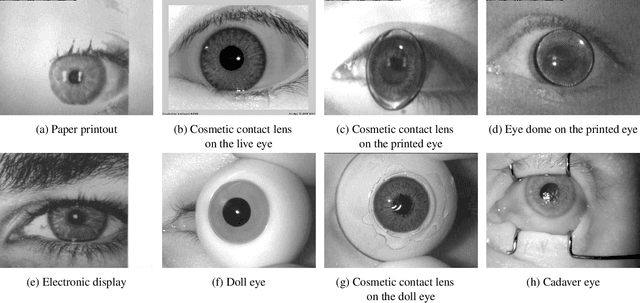


Abstract:Launched in 2013, LivDet-Iris is an international competition series open to academia and industry with the aim to assess and report advances in iris Presentation Attack Detection (PAD). This paper presents results from the fourth competition of the series: LivDet-Iris 2020. This year's competition introduced several novel elements: (a) incorporated new types of attacks (samples displayed on a screen, cadaver eyes and prosthetic eyes), (b) initiated LivDet-Iris as an on-going effort, with a testing protocol available now to everyone via the Biometrics Evaluation and Testing (BEAT)(https://www.idiap.ch/software/beat/) open-source platform to facilitate reproducibility and benchmarking of new algorithms continuously, and (c) performance comparison of the submitted entries with three baseline methods (offered by the University of Notre Dame and Michigan State University), and three open-source iris PAD methods available in the public domain. The best performing entry to the competition reported a weighted average APCER of 59.10\% and a BPCER of 0.46\% over all five attack types. This paper serves as the latest evaluation of iris PAD on a large spectrum of presentation attack instruments.
D-NetPAD: An Explainable and Interpretable Iris Presentation Attack Detector
Jul 02, 2020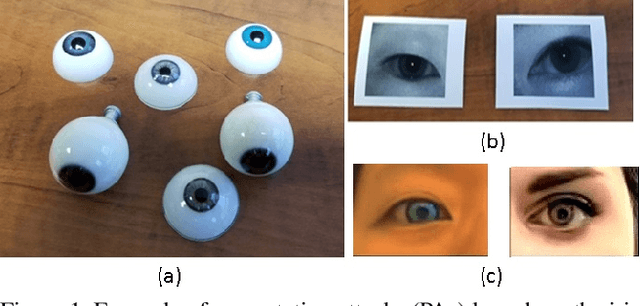



Abstract:An iris recognition system is vulnerable to presentation attacks, or PAs, where an adversary presents artifacts such as printed eyes, plastic eyes, or cosmetic contact lenses to circumvent the system. In this work, we propose an effective and robust iris PA detector called D-NetPAD based on the DenseNet convolutional neural network architecture. It demonstrates generalizability across PA artifacts, sensors and datasets. Experiments conducted on a proprietary dataset and a publicly available dataset (LivDet-2017) substantiate the effectiveness of the proposed method for iris PA detection. The proposed method results in a true detection rate of 98.58\% at a false detection rate of 0.2\% on the proprietary dataset and outperfoms state-of-the-art methods on the LivDet-2017 dataset. We visualize intermediate feature distributions and fixation heatmaps using t-SNE plots and Grad-CAM, respectively, in order to explain the performance of D-NetPAD. Further, we conduct a frequency analysis to explain the nature of features being extracted by the network. The source code and trained model are available at https://github.com/iPRoBe-lab/D-NetPAD.
Some Research Problems in Biometrics: The Future Beckons
May 12, 2019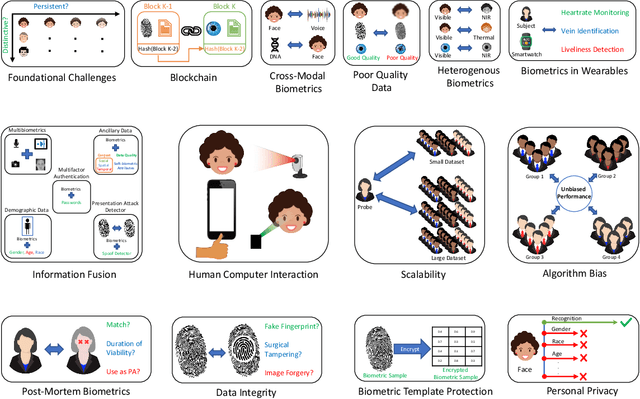

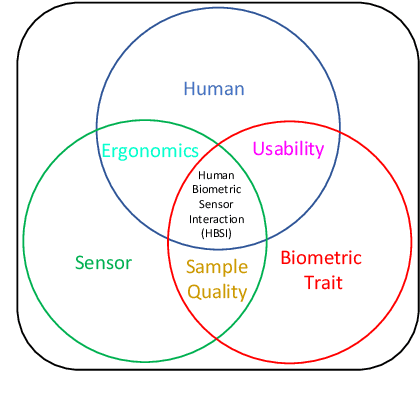
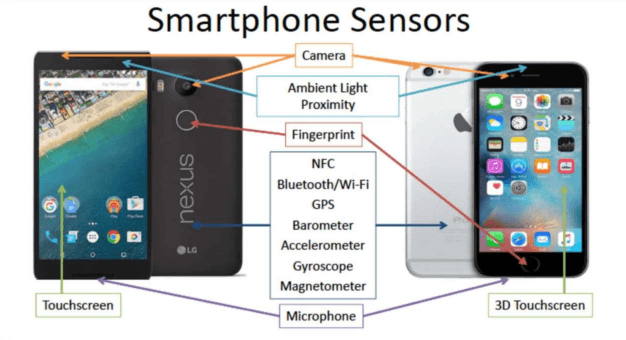
Abstract:The need for reliably determining the identity of a person is critical in a number of different domains ranging from personal smartphones to border security; from autonomous vehicles to e-voting; from tracking child vaccinations to preventing human trafficking; from crime scene investigation to personalization of customer service. Biometrics, which entails the use of biological attributes such as face, fingerprints and voice for recognizing a person, is being increasingly used in several such applications. While biometric technology has made rapid strides over the past decade, there are several fundamental issues that are yet to be satisfactorily resolved. In this article, we will discuss some of these issues and enumerate some of the exciting challenges in this field.
 Add to Chrome
Add to Chrome Add to Firefox
Add to Firefox Add to Edge
Add to Edge